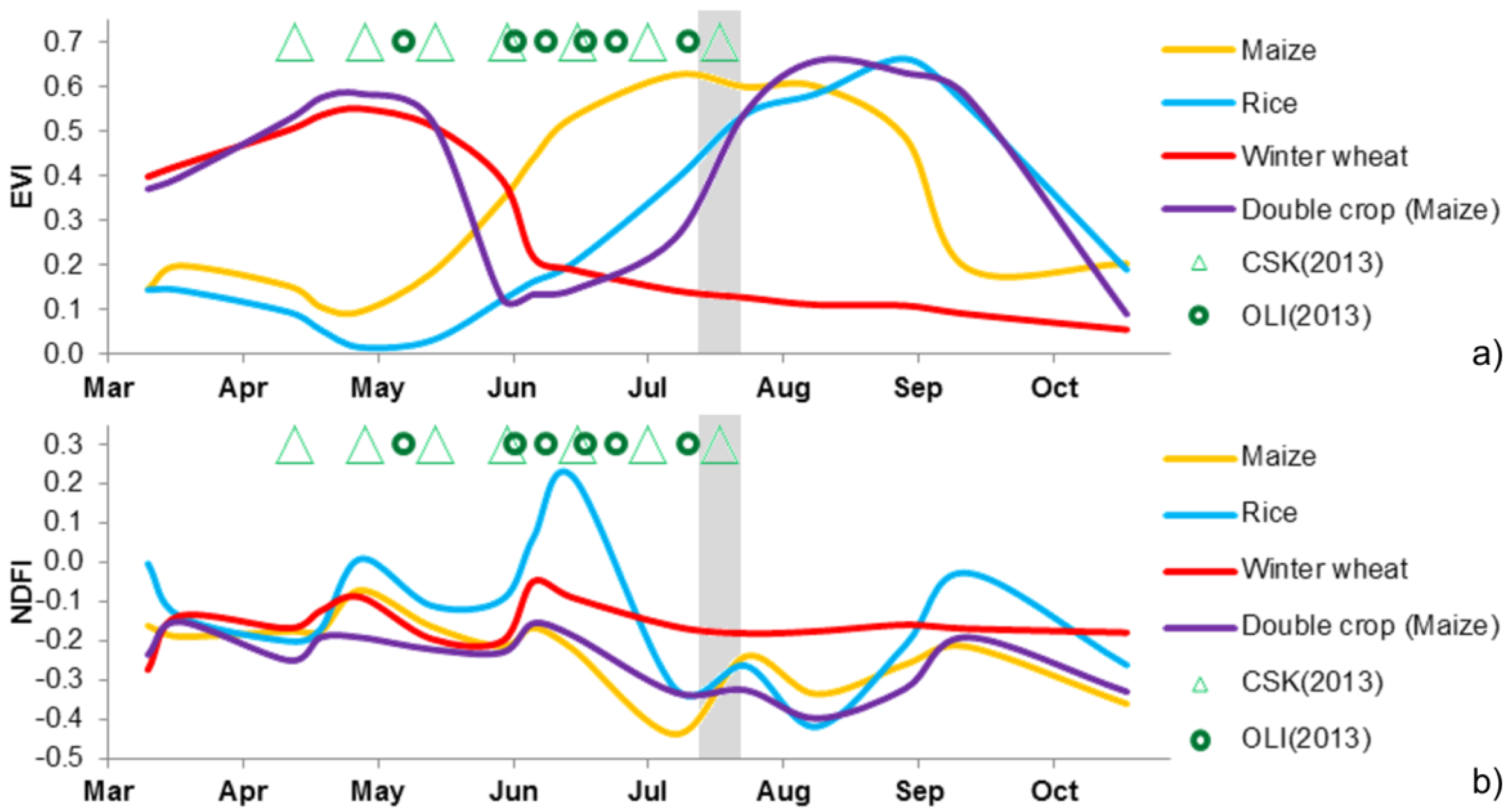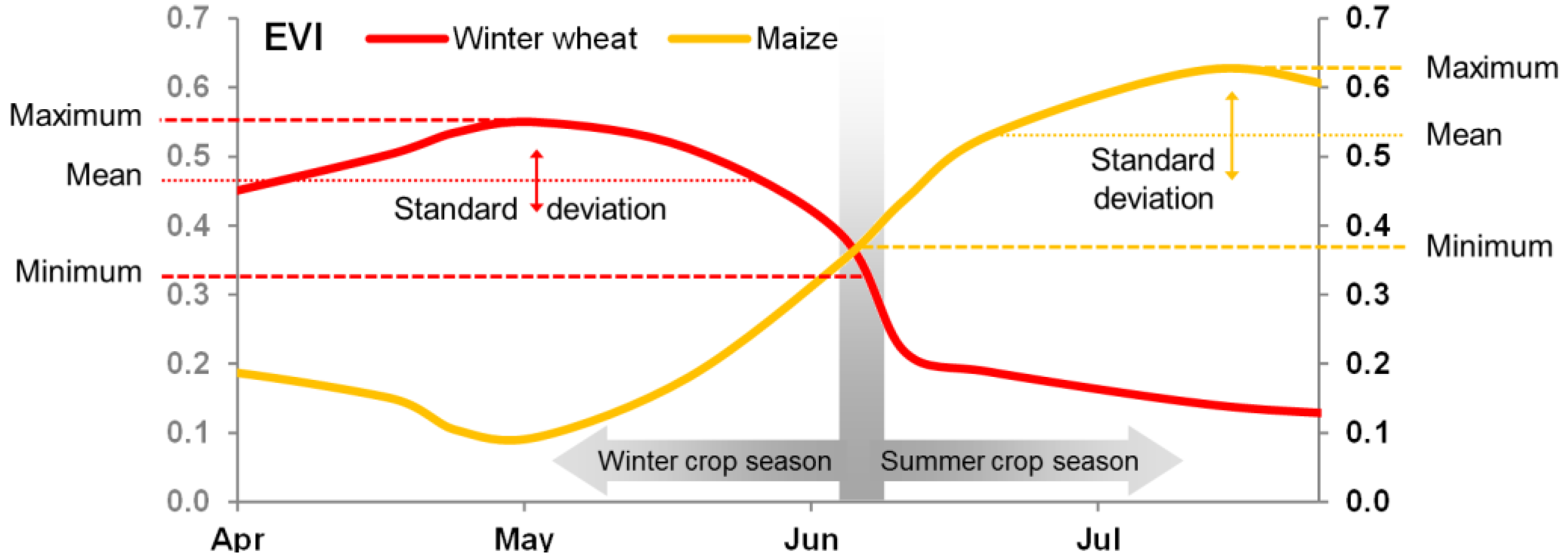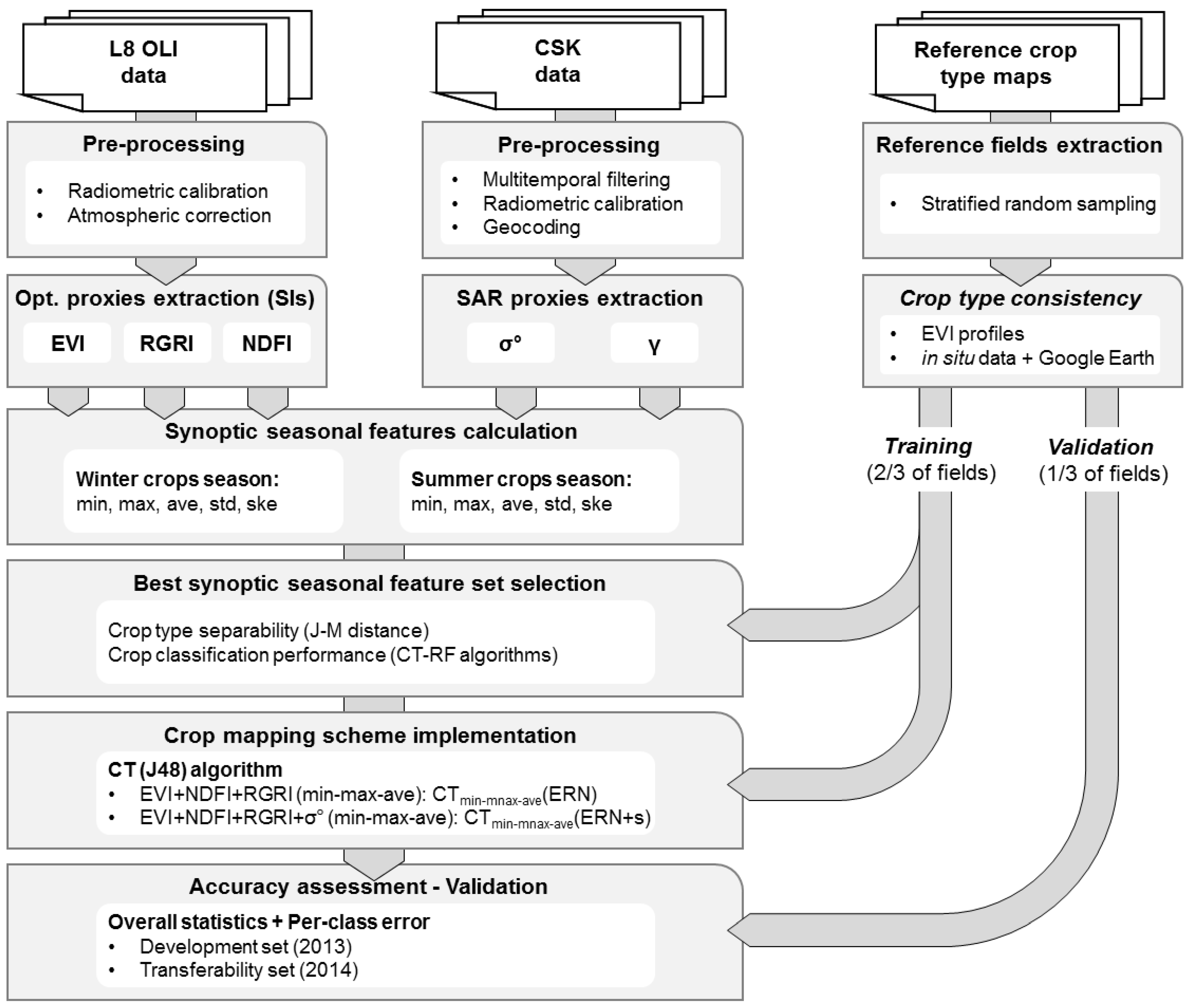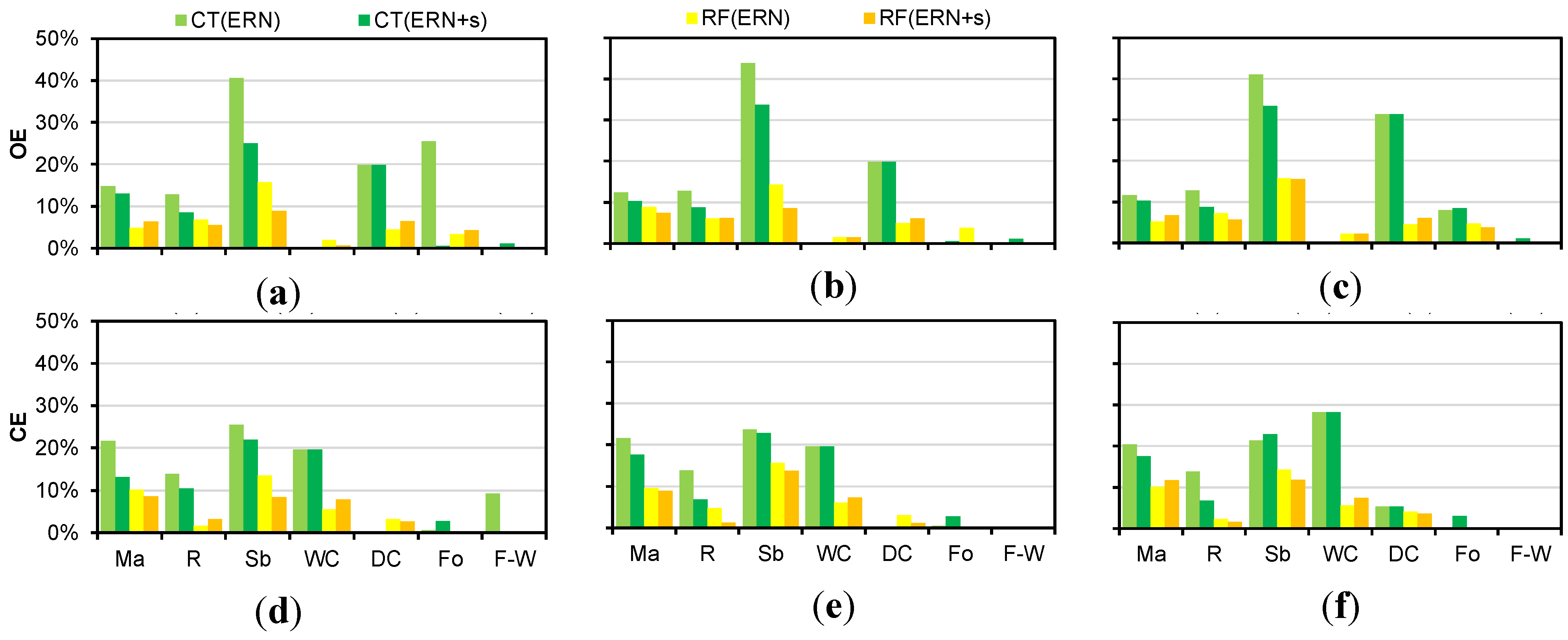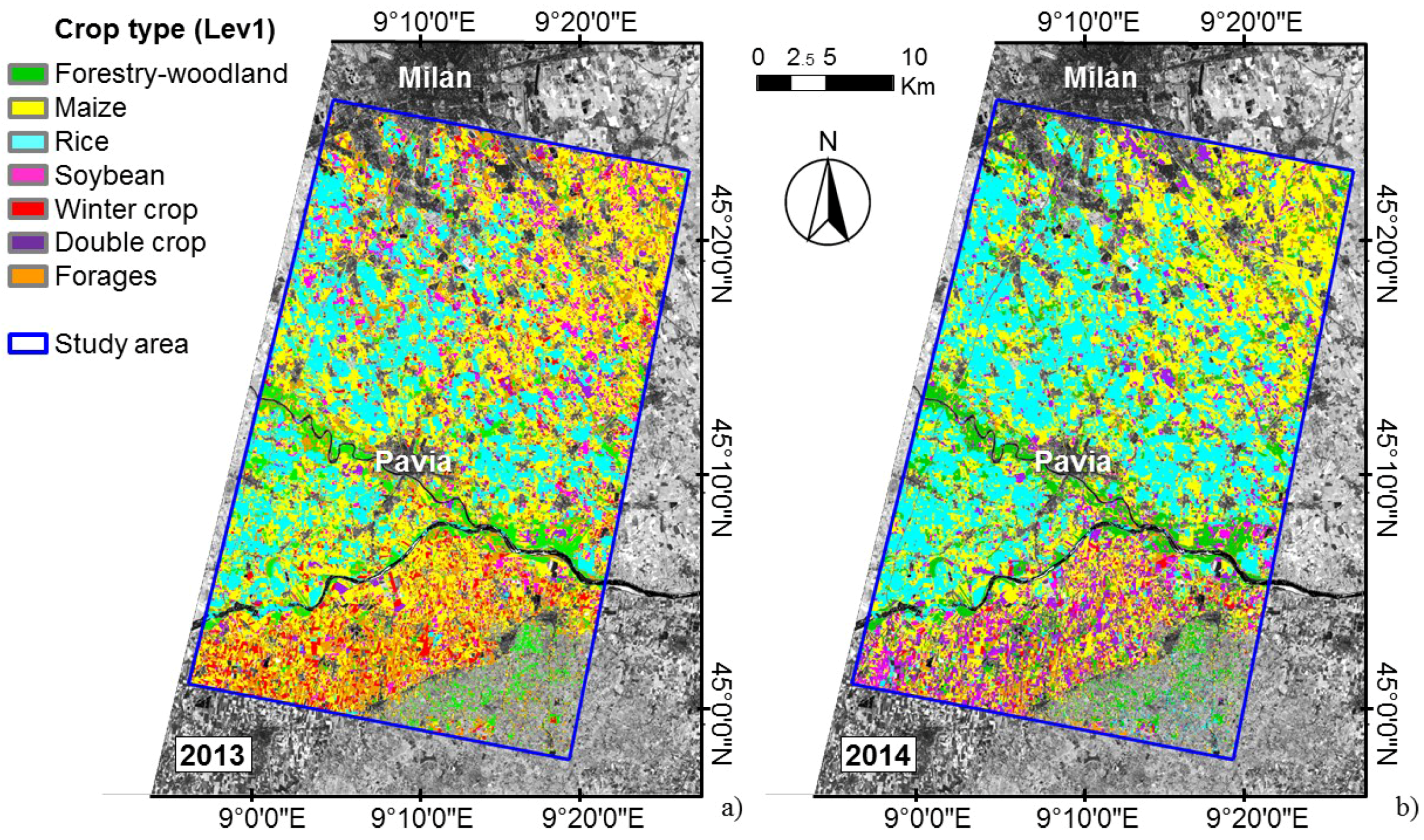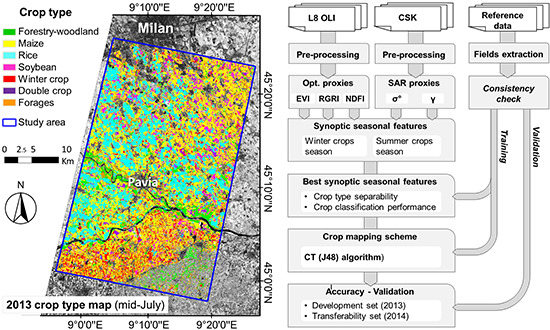4.1. Selection of Synoptic Seasonal Features
Since the separability scores for Lev2 classes were generally not high enough for expecting good performance in early mapping, Lev1 (
i.e., 7 crop classes) was chosen as the target level for our crop mapping approach. Class separability scores aggregated at Lev1 (
Table 4) show some interesting response to the different input proxy combinations (derived from optical and/or X-band SAR data).
Using only X-band SAR information, J-MDIST increases consistently for all classes when adding γ to σ°: from +0.041 for better separated classes (rice and forages), to +0.150 and up to +0.204 for crop classes difficult to separate using only σ° (maize, soybean, and double crop). Using optical proxies, a slighter but consistent increment in J-MDIST (0.037 to 0.053) is observed by adding NDFI to EVI for summer crops (maize, rice, and soybean). Further addition of RGRI brings a small, yet consistent, increment in J-MDIST (0.009 to 0.023) over summer crops. As regards separability achieved by using optical and SAR proxies together, an increment is observed adding σ° to the full optical feature set; since separability is already close to the maximum value (J-MDIST~2) the increment is lower for maize and soybean classes (+0.007 to +0.010). No significant increment (+0.000 to +0.002) is granted by further adding γ.
Based on separability scores shown in
Table 4, we kept only the best performing combinations in terms of overall separability (minimum JM
DIST > 1.98): EVI+NDFI+RGRI (ERN, J-M
DIST > 1.983) and EVI+NDFI+RGRI+σ° (ERN+s, J-M
DIST > 1.997). Since the scores achieved using EVI+NDFI+RGRI+σ° and EVI+NDFI+RGRI+σ°+γ synoptic features are not significantly different, we decided to discard the combination including γ to keep the feature set as simple as possible. These two combinations were used as input for the classification approach development.
Table 4.
Mean J-MDIST for each crop type class at Lev1, as a function of the combination of OLI and SAR proxies. Maximum separability corresponds to J-MDIST = 2.
Table 4.
Mean J-MDIST for each crop type class at Lev1, as a function of the combination of OLI and SAR proxies. Maximum separability corresponds to J-MDIST = 2.
| Crop Type (Lev1) | Combination of Seasonal Proxies Used |
|---|
| σ° | σ°+γ | EVI | EVI+NDFI | EVI+NDFI+RGRI | EVI+NDFI+RGRI+σ° | EVI+NDFI+RGRI+σ°+γ |
|---|
| Maize | 1.781 | 1.944 | 1.928 | 1.973 | 1.988 | 1.998 | 1.999 |
| Rice | 1.936 | 1.977 | 1.951 | 1.988 | 1.997 | 2.000 | 2.000 |
| Soybean | 1.784 | 1.934 | 1.907 | 1.960 | 1.983 | 1.997 | 1.999 |
| Winter crop | 1.921 | 1.988 | 1.998 | 1.999 | 1.999 | 2.000 | 2.000 |
| Double crop | 1.755 | 1.959 | 1.998 | 1.999 | 1.999 | 2.000 | 2.000 |
| Forages | 1.949 | 1.990 | 1.999 | 2.000 | 2.000 | 2.000 | 2.000 |
| Forestry-woodland | 1.927 | 1.990 | 1.999 | 2.000 | 2.000 | 2.000 | 2.000 |
Table 5 shows OA of preliminary crop classification tests using synoptic seasonal features extracted from ERN and ERN+s combinations at Lev1 and Lev0 as input for CT, with RF scores as reference. Results achieved with the complete features set (min-max-ave-std-ske) show that: (i) at Lev1, OA achieved with CT increases from 85.3% (ERN) to 89.0% (ERN+s), with a gap towards RF of 5.8%–8.9%; (ii) at Lev0, very high OA is scored by CT (96.7–97.8%), reducing the gap towards RF to 1.3%–2.5%. Reducing the input features to min-max-ave set did not produce a sensible decrement in OA, with maximum decrement in OA of −0.8% across different proxy combinations and thematic levels, while increments in OA for CT are observed using ERN: +1.2% (at Lev0) and +1.7% (at Lev1). Further reducing input features to min-max did not significantly change OA at Lev0, but a decrement up to 2.1% was observed for Lev1.
Figure 5 shows per-class omission and commission errors (OE and CE) at Lev1 for CT and RF. When the min-max-ave set is used, no significant increase of per-class errors is observed, compared to the use of a full set of features (min-max-ave-std-ske;
Figure 5b–e). Instead, the use of min-max-ave set and CT fed with optical only features (ERN) contributes to a reduction of OE for
forages (25%,
Figure 5b), and of CE for
forestry-woodland (9%,
Figure 5e). When the input feature set is further reduced to min-max (
Figure 5c–f), higher errors for
double crop (+11% OE, +5% CE), and some overestimation of
winter crop (+8% CE) are observed. The best performing synoptic seasonal feature set was therefore identified as min-max-ave, which was therefore selected as best option input for early crop mapping.
Figure 5.
Per-class omission (OE) and commission (CE) errors for Lev1 classes achieved by CT with ERN and ERN+s proxies and different synoptic seasonal feature sets: (a) OE with min-max-ave-std-ske; (b) OE with min-max-ave; (c) OE with min-max; (d) CE with min-max-ave-std-ske; (e) CE with min-max-ave; (f) CE with min-max. Ma = maize; R = rice; Sb = soybean; WC = winter crop; DC = double crop; Fo = forages; F-W = forestry-woodland; ERN = EVI+NDFI+RGRI; ERN = EVI+NDFI+RGRI+σ° = ERN+s. Results achievable using RF are shown as reference.
Figure 5.
Per-class omission (OE) and commission (CE) errors for Lev1 classes achieved by CT with ERN and ERN+s proxies and different synoptic seasonal feature sets: (a) OE with min-max-ave-std-ske; (b) OE with min-max-ave; (c) OE with min-max; (d) CE with min-max-ave-std-ske; (e) CE with min-max-ave; (f) CE with min-max. Ma = maize; R = rice; Sb = soybean; WC = winter crop; DC = double crop; Fo = forages; F-W = forestry-woodland; ERN = EVI+NDFI+RGRI; ERN = EVI+NDFI+RGRI+σ° = ERN+s. Results achievable using RF are shown as reference.
Table 5.
Overall Accuracy (OA) for CT at Lev1 and Lev0, using ERN and ERN+s proxy combinations and min-max-ave-std-ske, min-max-ave and min-max seasonal features. ERN = EVI+NDFI+RGRI; ERN = EVI+NDFI+RGRI+σ° = ERN+s. Results achievable using RF are shown as reference.
Table 5.
Overall Accuracy (OA) for CT at Lev1 and Lev0, using ERN and ERN+s proxy combinations and min-max-ave-std-ske, min-max-ave and min-max seasonal features. ERN = EVI+NDFI+RGRI; ERN = EVI+NDFI+RGRI+σ° = ERN+s. Results achievable using RF are shown as reference.
| OA | ERN | ERN+s |
|---|
| Method | Level | min-max-ave-std-ske | min-max-ave | min-max | min-max-ave-std-ske | min-max-ave | min-max |
|---|
| CT | Lev1 | 85.3% | 87.0% | 84.8% | 89.0% | 88.7% | 86.9% |
| Lev0 | 96.7% | 97.9% | 96.4% | 97.8% | 97.8% | 96.2% |
| RF (reference) | Lev1 | 94.2% | 93.4% | 93.9% | 94.8% | 94.6% | 93.8% |
| Lev0 | 99.2% | 99.2% | 99.1% | 99.1% | 99.3% | 99.0% |
4.2. In-Season Crop Type Classification
Figure 6 shows the two CT schemes implemented using the J48 algorithm for to the 2013 training dataset with the min-max-ave synoptic seasonal feature set, applied to the ERN (CT
min-max-ave(ERN),
Figure 6a) and ERN+s (CT
min-max-ave(ERN+s),
Figure 6b).
The CT scheme developed using only optical features (CT
min-max-ave(ERN)) shows the first split of tree nodes based on winter season RGRI maximum (RGRI
Wmax ≥ 1.361), separating pixels which are vegetated in May-June (right side) from non-vegetated ones (left side), thus distinguishing summer crops from winter crops, double crops and other agricultural land cover. The tree branches on the right side of
Figure 6a further split winter and double crops from non-sown land covers (
forages,
forestry-woodland) based on two combinations of EVI mean in early summer (EVI
Save), since the latter classes show high green fractional cover already during spring, when summer crops are not yet sown. All these nodes show crop type attribution errors lower than 2.4%, except for
winter crop class (9.6% cumulated node error). Left branches in
Figure 6a are populated by summer crop classes, characterized by low RGRI
Wmax. Below these branches, the main splits are based on NDFI maximum (>0.089) to separate flooded
rice fields (very accurate, with node error of 0.1%), and EVI maximum in winter-spring season (EVI
Wmax > 0.298) to identify early-cycle crops (mostly
maize). Crop type detection in lower level branches are due to a combination of EVI and RGRI features from both winter-spring and early summer features, and are meant to separate a mixture of
rice,
maize and
soybean; these branches are characterized by cumulative node error above 20% (high misclassification rate).
Figure 6.
Classification tree schemes implemented using: (a) OLI data only, min-max-ave(ERN) input set, and (b) integrated OLI and CSK data, min-max-ave(ERN+s) input set. Ma = maize; R = rice; Sb = soybean; WC = winter crop; DC = double crop; Fo = forages; F-W = forestry-woodland.
Figure 6.
Classification tree schemes implemented using: (a) OLI data only, min-max-ave(ERN) input set, and (b) integrated OLI and CSK data, min-max-ave(ERN+s) input set. Ma = maize; R = rice; Sb = soybean; WC = winter crop; DC = double crop; Fo = forages; F-W = forestry-woodland.
The classification scheme developed using integrated optical and X-band SAR features (CTmin-max-ave(ERN+s)) shows a main split for RGRI
Wmax ≥ 1.361, consistently with CT
min-max-ave(ERN). The branches on the right side highlight the contribution of X-band minimum backscatter in early summer for the discrimination of
forages from
forestry-woodland (σ°
Smin > 0.055). In the left branches, the major
rice class (flooded rice) is first identified based on maximum NDFI (as in CT
min-max-ave(ERN)) while
maize or
rice pixels showing very high X-band backscatter in early summer (σ°
Smax > 0.682) are separated from a mixture of
rice,
maize and
soybean. This mixture of summer crops is further untangled by a combination of winter season EVI, mean summer backscatter and RGRI peak scores. As previously noted for
Figure 6a scheme, these leftmost branches are characterized by high class attribution errors (>20%).
Figure 7 shows the in-season early crop maps produced using CT
min-max-ave(ERN+s) scheme applied to the 2013 and 2014 datasets.
4.3. Validation
Table 6 summarizes accuracy metrics (OA and
κ) for the crop maps shown in
Figure 7 and computed for two different validation sets, with crop class cardinality proportional to either the training set (case
t), or the actual cropland coverage of the area calculated from CUAA (case
r). For 2013, the accuracy scores retrieved using the two sets are highly consistent, with case
r giving slightly higher scores. OA achieved at Lev1 with 2013 ERN+s dataset, peaking at 91.8% over case
r set (
κ = 0.897), are 1.7% higher than when using only optical data (ERN). At Lev0, the performance of ERN and ERN+s data are nearly the same, with OA (
κ) around 98% (0.960) for both case
r and case
t validation sets.
Table 6.
OA and
κ computed for crop maps derived with the CT schemes of
Figure 6 applied to the development (2013) and transferability (2014) sets, with ERN and ERN+s input features. case
r = class distribution proportional to real case crop acreage (%); case
t = same class distribution of training set; ERN = EVI+NDFI+RGRI; ERN+s = EVI+NDFI+RGRI+σ°.
Table 6.
OA and κ computed for crop maps derived with the CT schemes of Figure 6 applied to the development (2013) and transferability (2014) sets, with ERN and ERN+s input features. case r = class distribution proportional to real case crop acreage (%); case t = same class distribution of training set; ERN = EVI+NDFI+RGRI; ERN+s = EVI+NDFI+RGRI+σ°.
| | Level | Input Features | 2013 Dataset | 2014 Dataset |
|---|
| Validation Set | ERN | ERN+s | ERN | ERN+s |
|---|
| OA | Lev1 | case t | 87.0% | 88.7% | - | - |
| case r | 90.1% | 91.8% | 66.9% | 86.6% |
| Lev0 | case t | 97.9% | 97.8% | - | - |
| case r | 98.2% | 98.2% | 85.6% | 92.4% |
| κ | Lev1 | case t | 0.839 | 0.860 | - | - |
| case r | 0.875 | 0.897 | 0.572 | 0.826 |
| Lev0 | case t | 0.960 | 0.959 | - | - |
| case r | 0.968 | 0.968 | 0.740 | 0.861 |
Classification performance over the transferability set (2014) shows very good accuracy scores at Lev0, yet lower than for 2013: OA = 85.6% (κ = 0.740) using optical features and OA = 92.4% (κ = 0.861) using optical and σ° features. An increment of 6.8% in OA is achieved at Lev0 by integrating σ° for 2014, while for 2013 no enhancement was observed. At Lev1, less consistent results are observed: using ERN input an OA = 66.9% was reached, 23.2% lower than 2013 results, while when ERN+s input are used, a rebound of +19.7% in OA is achieved, reaching 86.6% (κ = 0.826). This result highlights the significant contribution of X-band SAR backscattering in terms of transferability of the approach, i.e., when the classification scheme is applied to a seasonal dataset different from the one used for algorithm development. The additional information brought by X-band SAR increases the robustness of the mapping approach at Lev1.
Figure 7.
Early in-season crop maps produced using the CTmin-max-ave(ERN+s) scheme over the study area, for the year 2013 (a) and 2014 (b). Crop maps are overlaid on mid-July EVI (16 July 2013 for panel a, 19 July 2014 for panel b), represented in grey tones.
Figure 7.
Early in-season crop maps produced using the CTmin-max-ave(ERN+s) scheme over the study area, for the year 2013 (a) and 2014 (b). Crop maps are overlaid on mid-July EVI (16 July 2013 for panel a, 19 July 2014 for panel b), represented in grey tones.
Figure 8.
Class omission (OE) (a) and commission (CE) (b) errors at Lev1 for CTmin-max-ave approach implemented over development (year 2013) and transferability (year 2014) sets using different input features (ERN and ERN+s). Ma = maize; R = rice; Sb = soybean; WC = winter crop; DC = double crop; Fo = forages; F-W = forestry-woodland; ERN = EVI+NDFI+RGRI; ERN = EVI+NDFI+RGRI+σ° = ERN+s.
Figure 8.
Class omission (OE) (a) and commission (CE) (b) errors at Lev1 for CTmin-max-ave approach implemented over development (year 2013) and transferability (year 2014) sets using different input features (ERN and ERN+s). Ma = maize; R = rice; Sb = soybean; WC = winter crop; DC = double crop; Fo = forages; F-W = forestry-woodland; ERN = EVI+NDFI+RGRI; ERN = EVI+NDFI+RGRI+σ° = ERN+s.
Per-class errors were analyzed at Lev1, providing some insights into the disaggregation of global accuracy results (
Figure 8 and
Table 7). Using the 2013 validation dataset (case
r), depicted in light and dark green bars of
Figure 8 and in the two upper matrices of
Table 7, OE and CE are consistently lower than 25% for all classes, with the exception of
soybean (OE = 25.3%–40.7%, CE = 50.7%–55.0%, with either ERN or ERN+s input), which is mainly misclassified as
maize. For the
soybean class, the use of X-band σ° results in a OE reduction of 15.4%, due to less confusion with other summer crops, and in a CE reduction of 4.3%, due to less confusion with
rice; a reduction of 4.9% CE for
rice is also registered using ERN+s input, while errors over other crop types are stable. The best performances, with class errors not exceeding 10% and balanced between omission and commission, are achieved for
maize (OE = 9.3%, CE = 10.6%),
rice (OE = 9.3%, CE = 1.6%),
forages (OE = 0.1%, CE = 0.5%), and
forestry-woodland (OE = 0.6%, CE = 0.1%). Tendencies to overestimation for
winter crop (CE = 16.8%) and to underestimation for
double crop (OE = 23.7%) are observed, due to mutual confusion between these two classes.
Table 7.
Confusion matrices of early in-season crop maps produced using the CT scheme implemented over development (2013) and transferability (2014) sets, with ERN and ERN+s input features. Figures are expressed in hectares [ha]. ERN = EVI+NDFI+RGRI; ERN = EVI+NDFI+RGRI+σ° = ERN+s.
Table 7.
Confusion matrices of early in-season crop maps produced using the CT scheme implemented over development (2013) and transferability (2014) sets, with ERN and ERN+s input features. Figures are expressed in hectares [ha]. ERN = EVI+NDFI+RGRI; ERN = EVI+NDFI+RGRI+σ° = ERN+s.
| | | | | Reference Dataset |
|---|
| | | | | Maize | Rice | Soybean | Winter crop | Double Crop | Forages | Forestry-woodland |
|---|
| Development Set | CTmin-max-ave(ERN) | 2013 | Maize | 95.6 | 8.6 | 14.6 | 0.0 | 0.5 | 0.0 | 0.1 |
| Rice | 4.3 | 85.1 | 6.2 | 0.0 | 0.0 | 0.0 | 0.0 |
| Soybean | 5.7 | 2.3 | 29.7 | 0.0 | 0.0 | 0.0 | 0.0 |
| Winter crop | 0.0 | 0.0 | 0.0 | 29.1 | 7.7 | 0.0 | 0.0 |
| Double Crop | 0.0 | 0.0 | 0.0 | 0.0 | 28.3 | 0.0 | 0.0 |
| Forages | 0.0 | 0.0 | 0.0 | 0.0 | 0.0 | 19.1 | 0.0 |
| Forestry-woodland | 0.0 | 0.0 | 0.0 | 0.0 | 0.0 | 0.0 | 47.4 |
| CTmin-max-ave(ERN+s) | 2013 | Maize | 95.8 | 8.6 | 12.4 | 0.0 | 0.0 | 0.0 | 0.1 |
| Rice | 0.4 | 87.4 | 4.2 | 0.0 | 0.0 | 0.0 | 0.0 |
| Soybean | 9.5 | 0.0 | 33.8 | 0.0 | 0.4 | 0.0 | 0.0 |
| Winter crop | 0.0 | 0.0 | 0.0 | 29.1 | 7.7 | 0.0 | 0.0 |
| Double Crop | 0.0 | 0.0 | 0.0 | 0.0 | 28.4 | 0.0 | 0.0 |
| Forages | 0.0 | 0.0 | 0.0 | 0.0 | 0.0 | 19.1 | 0.3 |
| Forestry-woodland | 0.0 | 0.0 | 0.0 | 0.0 | 0.0 | 0.0 | 47.2 |
| Transferability Set | CTmin-max-ave(ERN) | 2014 | Maize | 61.0 | 26.8 | 8.6 | 0.0 | 2.5 | 0.0 | 0.1 |
| Rice | 6.6 | 41.0 | 30.2 | 0.0 | 0.0 | 0.0 | 0.0 |
| Soybean | 0.0 | 0.0 | 0.0 | 0.0 | 0.0 | 0.0 | 0.0 |
| Winter crop | 0.0 | 0.0 | 0.0 | 14.6 | 0.0 | 0.0 | 0.0 |
| Double Crop | 0.0 | 0.0 | 0.0 | 19.9 | 27.6 | 0.5 | 0.0 |
| Forages | 0.0 | 0.0 | 0.0 | 0.0 | 8.9 | 24.2 | 34.7 |
| Forestry-woodland | 0.0 | 0.0 | 0.0 | 0.0 | 1.4 | 0.0 | 29.8 |
| CTmin-max-ave(ERN+s) | 2014 | Maize | 62.8 | 0.0 | 13.3 | 0.0 | 0.0 | 0.0 | 0.0 |
| Rice | 4.8 | 67.8 | 25.2 | 0.0 | 0.0 | 0.0 | 0.1 |
| Soybean | 0.0 | 0.0 | 0.3 | 0.0 | 2.3 | 0.0 | 0.0 |
| Winter crop | 0.0 | 0.0 | 0.0 | 14.6 | 0.0 | 0.0 | 0.0 |
| Double Crop | 0.0 | 0.0 | 0.0 | 19.9 | 28.1 | 0.5 | 0.0 |
| Forages | 0.0 | 0.0 | 0.0 | 0.0 | 5.3 | 22.4 | 0.1 |
| Forestry-woodland | 0.0 | 0.0 | 0.0 | 3.4 | 3.2 | 0.0 | 64.4 |
When the CT
min-max-ave scheme is applied to 2014 data (transferability set) in case
r (
Figure 8, light and dark orange bars,
Table 7, two lower confusion matrices), some different patterns emerge: both CE and OE are greater than 2013 over most of the classes. A remarkable case is represented by
soybean, with OE = 100.0%, meaning that this class is not represented in the classified pixels belonging to 2014 validation set. These pixels are mistakenly classified as
rice (78%) and
maize (22%). Other major discrepancies between 2013 and 2014 per-class accuracy occur for
winter crop and
double crop classes: for the former, the 2014 crop map is strongly underestimating (OE = 58%), while for the latter the rather conservative 2013 performance (CE = 0%) is not repeated for 2014 (CE > 40%, OE > 30%). The overestimation of
winter crop is due to confusion with
double crop, while the errors observed for
double crop come from misclassification not only with
winter crop, but also with
forages. This could be due to the timing of 2014 acquisition dates, which less effectively capture the single and double crop dynamics compared to 2013 data. The high OE for
forestry-woodland (56%) is instead due to class confusion with
forages.
The integration of σ° for the 2014 dataset (ERN+s) results in very small changes of OE for soybean, winter crop and double crop, while it brings an improvement for maize (OE = 7.0%, CE = 4.9%), rice (OE = 0.2%, CE = 12.4%), forages (OE = 14.9%, CE = 20.0%), and forestry-woodland (OE = 0.3%, CE = 11.7%); this is mainly due to the reduced confusion between rice and maize and between forages and forestry-woodland. Still, per-class performances using ERN+s over 2014 are generally worse than for 2013, especially over crop classes more sensitive to the seasonal climatic conditions (e.g., double crop and soybean, usually sown late in summer season in Lombardy and thus prone to meteorological fluctuations). A different behavior is shown by rice, with a slight overestimation of class extent for 2014 dataset (<OE, >CE), compared to 2013 results. In summary, CTmin-max-ave performance using ERN+s input is better than with ERN for most of the crop types at Lev1 and outputs acceptable class accuracies ranging from 62.8% for double crop, to >90% for forestry-woodland (94.0%), rice (93.8%), and maize (94.6%). Important misclassification errors are observed for soybean class across the inter-annual dataset.
4.4. Error Reduction Strategy
Since Lev1 map assessment showed some misclassification for summer crop classes (especially on 2014 dataset), we tested an expert-based ex-post pruning of the CT
min-max-ave scheme, implemented by restructuring the set of rules for branches with higher class attribution cumulated error (>20%). The rationale is to test the performance of a classifier which reduces the overall classification error at the expenses of the detail of the thematic level. This way, we generate a crop map which is only partially at Lev1 detail (see
Table 7 for Lev1 areal coverage percentage), by grouping summer crops, which are in the left branches of the schemes shown in
Figure 6 together into a generic crop type label (generic
summer crop, SCg) (
Figure 9). These re-structured crop mapping schemes, implemented for both ERN and ERN+s are respectively named: CT’
min-max-ave(ERN), shown in
Figure 9a, and CT’
min-max-ave(ERN+s) scheme, shown in
Figure 9b.
Validation was carried out using the same validation sets used for assessing CT
min-max-ave results, by excluding the areas labelled as SCg, which are classified now at Lev0. As a consequence, CT’
min-max-ave early crop maps do not cover the whole study area at Lev1 and some of the cropland is mapped at Lev0.
Table 8 summarizes accuracy metrics of the CT’
min-max-ave scheme calculated for two validation datasets: case
t and case
r. The Lev1 classified coverage ranges from a minimum of 84% (obtained for the ERN 2013 map), to a maximum of 94% of the total study site cropland area (for the ERN 2014 map). As expected, the global accuracy scores achieved with the ex-post pruned schemes are higher than the ones derived with the original CT
min-max-ave schemes: OA (
κ) increases by 4.6–4.7% (0.047–0.062) for the year 2013 and by 3.7% (0.051–0.053) for the year 2014. As observed for the original scheme, the best performance for CT’
min-max-ave is still achieved over the development set (2013), with OA~95% (
κ~0.94). For the transferability set (2014), OA decreases to 70.6% using ERN input, but still a strong rebound of +19.7% (up to 90.3%) is achieved by adding X-band σ° (ERN+s set), with
κ increasing from 0.625 to 0.877; the positive contribution of CSK based information for 2014 dataset is thus confirmed.
Figure 9.
CT’min-max-ave classification tree schemes for: (a) ERN, and (b) ERN+s input dataset. Ma = maize; R = rice; SCg = summer crop (generic); WC = winter crop; DC = double crop; Fo = forages; F-W = forestry-woodland.
Figure 9.
CT’min-max-ave classification tree schemes for: (a) ERN, and (b) ERN+s input dataset. Ma = maize; R = rice; SCg = summer crop (generic); WC = winter crop; DC = double crop; Fo = forages; F-W = forestry-woodland.
Table 8.
Accuracy performance at Lev1 assessed using the CT’min-max-ave scheme (excluding the generic summer crop class), with either ERN or ERN+s input dataset, expressed in terms of OA and κ. The cropland area percentage classified at Lev1 is included. case r = validation set with class distribution proportional to real case crop acreage percent coverage; case t = validation set with class distribution same as training set; ERN = EVI+NDFI+RGRI; ERN = EVI+NDFI+RGRI+σ° = ERN+s.
Table 8.
Accuracy performance at Lev1 assessed using the CT’min-max-ave scheme (excluding the generic summer crop class), with either ERN or ERN+s input dataset, expressed in terms of OA and κ. The cropland area percentage classified at Lev1 is included. case r = validation set with class distribution proportional to real case crop acreage percent coverage; case t = validation set with class distribution same as training set; ERN = EVI+NDFI+RGRI; ERN = EVI+NDFI+RGRI+σ° = ERN+s.
| | Validation Set | Input Features |
|---|
| | 2013 Dataset | 2014 Dataset |
|---|
| | ERN | ERN+s | ERN | ERN+s |
|---|
| OA | case t | 95.0% | 95.5% | - | - |
| case r | 94.8% | 95.4% | 70.6% | 90.3% |
| κ | case t | 0.939 | 0.945 | - | - |
| case r | 0.937 | 0.944 | 0.625 | 0.877 |
| Lev1 coverage | | 88% | 84% | 94% | 90% |
Per-class error analysis (
Figure 10) shows that the re-structured schemes provide an improvement only to CE of the summer crop classes,
maize and
rice (being
soybean excluded as target here) with a significant reduction for
rice CE (4.4%) over 2014 using ERN+s input set. In summary, the CT’
min-max-ave showed slight but consistently better performance of the original scheme, and could be adopted as error reduction strategy when the proposed crop mapping approach is applied to different conditions; this would lead to a crop map with different thematic levels: Lev1,
i.e., distinguishing the majority of
rice and
maize fields , and Lev0.
Figure 10.
Class error at Lev1 for the CT’min-max-ave scheme over development (2013) and transferability (2014) sets, using different input features (ERN and ERN+s): (a) OE, (b) CE. Ma = maize; R = rice; SCg = summer crop (generic); WC = winter crop; DC = double crop; Fo = forages; F-W = forestry-woodland; ERN = EVI+NDFI+RGRI; ERN = EVI+NDFI+RGRI+σ° = ERN+s.
Figure 10.
Class error at Lev1 for the CT’min-max-ave scheme over development (2013) and transferability (2014) sets, using different input features (ERN and ERN+s): (a) OE, (b) CE. Ma = maize; R = rice; SCg = summer crop (generic); WC = winter crop; DC = double crop; Fo = forages; F-W = forestry-woodland; ERN = EVI+NDFI+RGRI; ERN = EVI+NDFI+RGRI+σ° = ERN+s.

